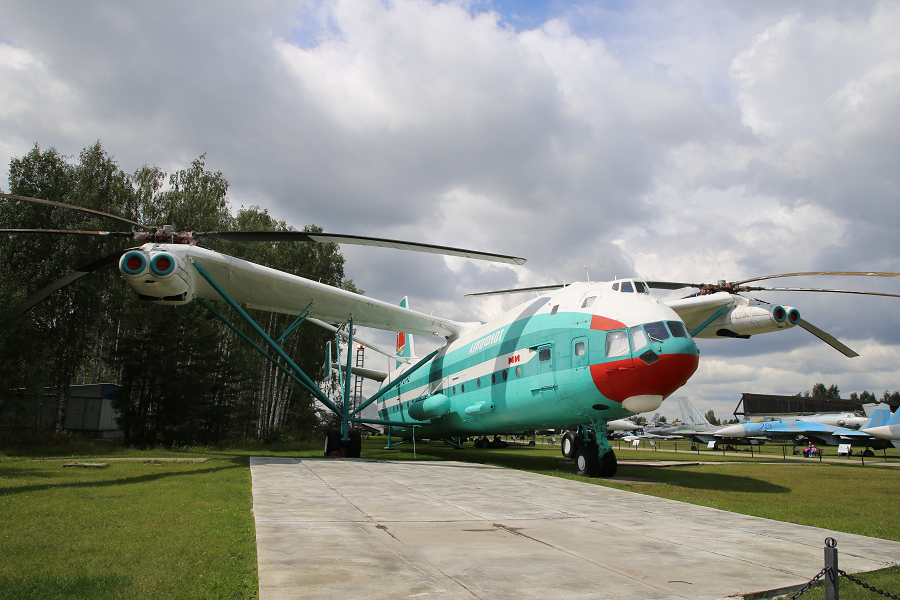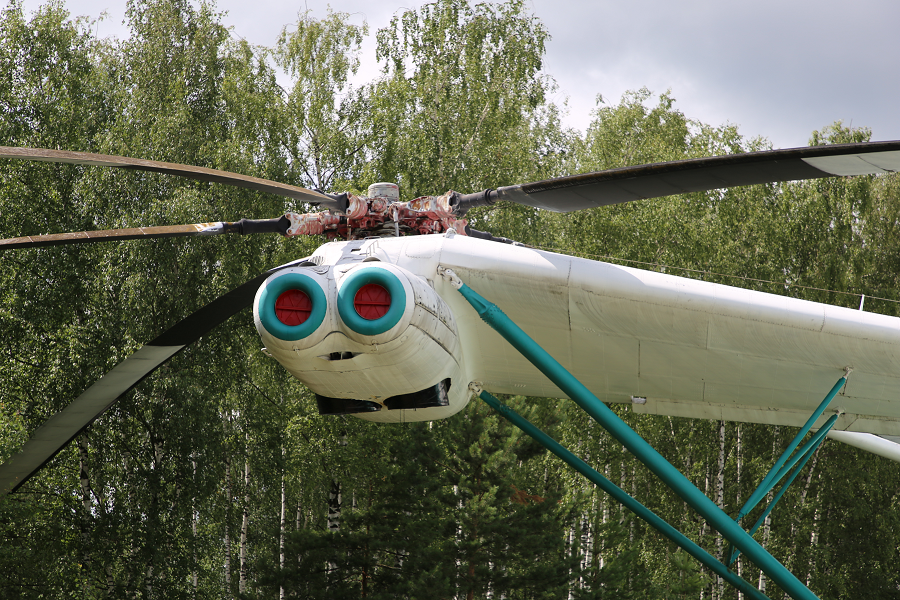Mi-12 (V12). Heavy transport helicopter from 1967. Designed by M. Mil bureau. Payload-to-height record (40 t on the altitude of 2250 m) was set on this helicopter. Flight range – 440 km with max. speed 260 km/h
The Mil V-12 (NATO reporting name: Homer), given the project number Izdeliye 65 (“Item 65”), is a prototype helicopter designed in the Soviet Union and the largest helicopter ever built. The designation “Mi-12” would have been the designation for the production helicopter and did not apply to V-12 prototypes.
Design studies for a giant helicopter were started at the Mil OKB in 1959, receiving official sanction in 1961 by the GKAT (Gosudarstvenny Komitet po Aviatsionnoy Tekhnike – State Committee on Aircraft Technology) instructing Mil to develop a helicopter capable of lifting 20 to 25 tonnes (22 to 28 short tons). The GKAT directive was followed by a more detailed specification for the V-12 with hold dimensions similar to the Antonov An-22, intended to lift major items of combat materiel as well as 8K67, 8K75 and 8K82 inter-continental ballistic missiles (ICBM).
Design limitations forced Mil to adopt a twin rotor system but design studies of a tandem layout, similar to the Boeing CH-47 Chinook, revealed major problems. The single rotor layouts also studied proved to be non-viable, leading to the transverse layout chosen for the finished article.
The transverse rotor system of the V-12, which eliminates the need for a tail rotor, consists of two Mil Mi-6 transmission systems complete with rotors mounted at the tips of the approximately 30 m (100 ft) span inverse tapered wings. Although the first use by Mil, the transverse system had been used by several of the early helicopters, including the Focke-Wulf Fw 61, Focke-Achgelis Fa 223 Drache and Kamov Ka-22 Vintokryl convertiplane.
General characteristics
Crew: 6 (pilot, copilot, flight engineer, electrician, navigator, radio operator)
Capacity: 196 passengers
normal 20,000 kg (44,000 lb)
maximum 40,000 kg (88,000 lb)
Length: 37 m (121 ft 5 in)
Wingspan: 67 m (219 ft 10 in) across rotors
Height: 12.5 m (41 ft 0 in)
Empty weight: 69,100 kg (152,339 lb)
Gross weight: 97,000 kg (213,848 lb)
Max takeoff weight: 105,000 kg (231,485 lb)
Freight compartment: 28.15×4.4×4.4 m (92 ft 4 in×14 ft 5 in×14 ft 5 in)
Powerplant: 4 × Soloviev D-25VF turboshaft engines, 4,800 kW (6,500 shp) each 26,000 HP total
Main rotor diameter: 2 × 35 m (114 ft 10 in)
Main rotor area: 962 m2 (10,350 sq ft) two 5-bladed rotors located transversely, area is per rotor (1 924 m2 total area)
Performance
Maximum speed: 260 km/h (160 mph, 140 kn)
Cruise speed: 240 km/h (150 mph, 130 kn)
Range: 500 km (310 mi, 270 nmi)
Ferry range: 1,000 km (620 mi, 540 nmi) with external fuel tanks
Service ceiling: 3,500 m (11,500 ft)
Disk loading: 50.5 kg/m2 (10.3 lb/sq ft) at gross weight
Hovering ceiling in ground effect: 10 m (33 ft)
Hovering ceiling out of ground effect: 600 m (1,969 ft)













